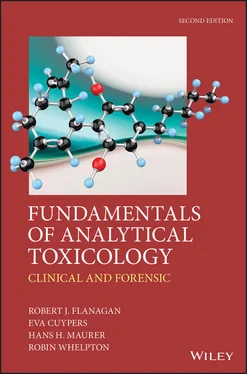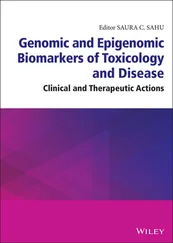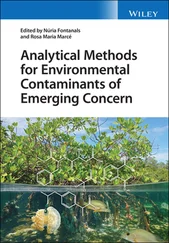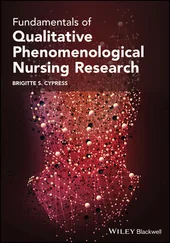Control of occupational exposure to toxic metals, volatile solvents, and of some other substances is an integral part of industrial hygiene and has been achieved, in part, by monitoring ambient air concentrations of the compound(s) under investigation. However, an individual's work pattern and attention to safety procedures may greatly influence exposure and ‘biological effect’ monitoring, where clinical chemical parameters such as blood zinc protoporphyrin are measured as an indicator of lead exposure, is required practice in certain occupations.
Not all poisons are amenable to effect monitoring and so ‘biological’ monitoring is performed widely. This involves measuring blood, urinary, or breath concentrations of a compound, and possibly of its metabolites. The ACGIH (2018) recommends Threshold Limit Values (TLVs) for more than 700 chemical substances and physical agents. There are also more than 50 Biological Exposure Indices (BEIs) that cover more than 80 chemical substances. The DFG (2018) ‘MAK List’ (maximum allowable concentration in workplace air) classifies more than 1000 compounds according to their toxicological profile and gives threshold values for their use.
The investigation of the accidental release of chemicals into the workplace or into the environment (so-called chemical incidents) is an important area. Examples include the Bhopal disaster in India when methyl isocyanate was released into the atmosphere and the Camelford incident in the UK, in which aluminium sulfate was accidentally added to the local drinking water supply. Toxicological analyses can be valuable not only in providing evidence of the nature and magnitude of an exposure, but also in demonstrating that no significant exposure has occurred, thereby allaying public apprehension. Clearly, the early collection of appropriate biological samples is essential.
In the absence of information to the contrary it is wise to collect 10 mL whole blood (2 x 5 mL EDTA anticoagulant) and at least 25–50 mL urine (no preservative) from exposed or possibly exposed individuals. The time and date of sampling and the patient's full names should be recorded on the samples and also on a separate record sheet. The samples should be stored at either 4 °C or –20 °C until the appropriate analyses can be arranged. If the incident is investigated in retrospect then samples may exist in a local hospital laboratory, for example.
The increasing use of herbal or other ‘natural’ remedies is an area of especial concern. Whilst most, but by no means all, herbal preparations are innocuous (Belsey & Karch, 2015; Byeon et al ., 2019), adulteration or contamination with dust, pollens, insects, rodents, parasites, microbes, fungi, mould, toxins, pesticides, toxic metals, and/or prescription drugs, is not uncommon (Byard, 2010; Posadzki et al ., 2013; Steyn et al ., 2018). This adds to the difficulty of diagnosing poisoning with these agents, each of which many contain dozens if not hundreds of different compounds, all at relatively low concentrations.
One area that has been neglected somewhat is that of food-derived poisons. Botulinum toxin and other toxins of microbiological origin are usually considered together with food poisoning. Poisoning from other naturally occurring substances, which include atropine from Atropa belladonna , solanine from potatoes, and cyanide from Cassava and from apple pips, also occurs, sometimes with homicidal intent (Bonnici et al ., 2010). Here analysis of the foodstuff rather than biological samples can be more helpful in establishing the diagnosis in individual patients. Acute pesticide poisoning sometimes occurs after ingestion of contaminated produce and again analysis of the foodstuff can be helpful (Nasreddine & Parent-Massin, 2002).
It is impossible to divorce the study of the analytical methods used in performing toxicological analysis on biological and related samples from the study of toxicology itself, especially clinical and forensic toxicology. By the same token, the laboratory can do nothing to help in the diagnostic process unless someone, be it a clinician, pathologist, or some other person, first suspects poisoning and ensures that specimens are collected and sent for analysis. However, appropriate sample collection and handling is not always straightforward and indeed is a subject in its own right.
1 ACGIH (American Conference of Governmental Industrial Hygienists). TLVs and BEIs based on the documentation of the threshold limit values for chemical and physical agents and biological exposure indices. Cincinnati, OH: ACGIH, 2018.
2 Balcaen L, Bolea-Fernandez E, Resano M, Vanhaecke F. Inductively coupled plasma-tandem mass spectrometry (ICP-MS/MS): A powerful and universal tool for the interference-free determination of (ultra)trace elements – A tutorial review. Anal Chim Acta 2015; 894: 7–19.
3 Belsey SL, Flanagan RJ. Postmortem biochemistry: Current applications. J Forensic Leg Med 2016; 41: 49–57.
4 Belsey SL, Karch SB. Substance misuse: Herbal medicine. In: Encyclopedia of Forensic and Legal Medicine. Edition 2. Ed. Payne-James J, Byard RW. Oxford: Elsevier, 2015: 377–87.
5 Bonnici K, Stanworth D, Simmonds MS, Mukherjee E, Ferner RE. Flowers of evil. Lancet 2010; 376: 1616.
6 Byard RW. A review of the potential forensic significance of traditional herbal medicines. J Forensic Sci 2010; 55: 89–92.
7 Byeon JH, Kil JH, Ahn YC, Son CG. Systematic review of published data on herb induced liver injury. J Ethnopharmacol 2019; 233: 190–6.
8 Cuypers E, Flanagan RJ. The interpretation of hair analysis for drugs and drug metabolites. Clin Toxicol 2018; 56: 90–100.
9 DFG (Deutsche Forschungsgemeinschaft). List of MAK and BAT values 2018. Commission for the investigation of health hazards of chemical compounds in the work area. Report 54. Weinheim: Wiley VCH, 2018 ( https://onlinelibrary.wiley.com/doi/pdf/10.1002/9783527818402.oth).
10 Flanagan RJ. The investigation of poisoning in infants and young children. In: Investigation of Sudden Infant Death Syndrome. Ed. Cohen M, Scheimberg I, Beckwith JB, Hauck FR. Cambridge: Cambridge University Press, 2019: 106–15.
11 Flanagan RJ, Jones GR, Maurer HH, Meyer MR. Suspicion of poisoning. In: Handbook of Forensic Medicine. Ed. Madea B. Chichester: Wiley, 2013: 845–65.
12 Fortuna A, Alves G, Falcão A. Chiral chromatographic resolution of antiepileptic drugs and their metabolites: a challenge from the optimization to the application. Biomed Chromatogr 2014; 28: 27–58.
13 Grapp M, Kaufmann C, Streit F, Binder L. Systematic forensic toxicological analysis by liquid-chromatography-quadrupole-time-of-flight mass spectrometry in serum and comparison to gas chromatography-mass spectrometry. Forensic Sci Int 2018; 287: 63–73.
14 Grapp M, Maurer HH, Desel H. Systematic forensic toxicological analysis by GC-MS in serum using automated mass spectral deconvolution and identification system. Drug Test Anal 2016; 8: 816–25.
15 Gulson B. Stable lead isotopes in environmental health with emphasis on human investigations. Sci Total Environ 2008; 400: 75–92.
16 Handley SA, Ramsey JD, Flanagan RJ. Substance misuse-related poisoning deaths, England and Wales, 1993–2016. Drug Sci Policy Law 2018; 4: 1–18.
17 Harrison J, Fell T, Leggett R, Lloyd D, Puncher M, Youngman M. The polonium-210 poisoning of Mr Alexander Litvinenko. J Radiol Prot 2017; 37: 266–78.
18 Hsu KC, Sun CC, Huang YL. Arsenic speciation in biomedical sciences: Recent advances and applications. Kaohsiung J Med Sci 2011; 27: 382–9.
19 Nguyen LA, He H, Pham-Huy C. Chiral drugs: An overview. Int J Biomed Sci 2006; 2: 85–100.
20 Maurer HH. Systematic toxicological analysis procedures for acidic drugs and/or metabolites relevant to clinical and forensic toxicology and/or doping control. J Chromatogr B 1999; 733: 3–25.
Читать дальше












